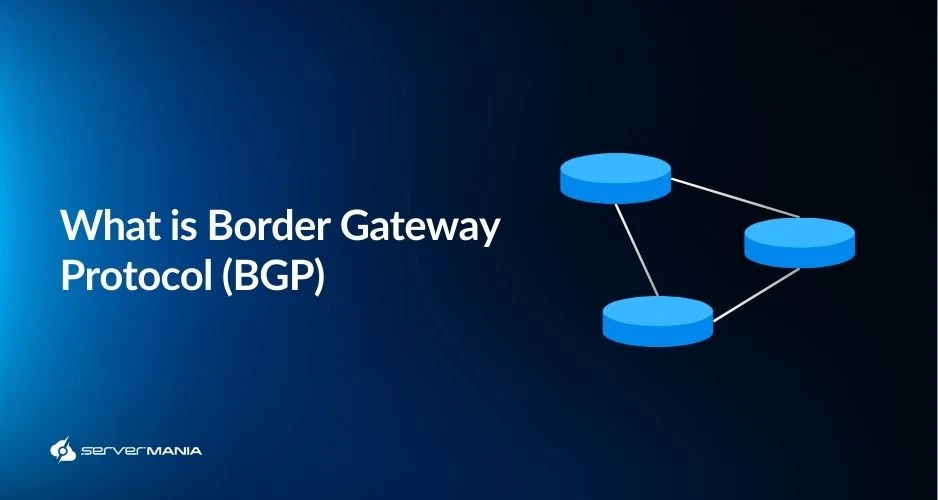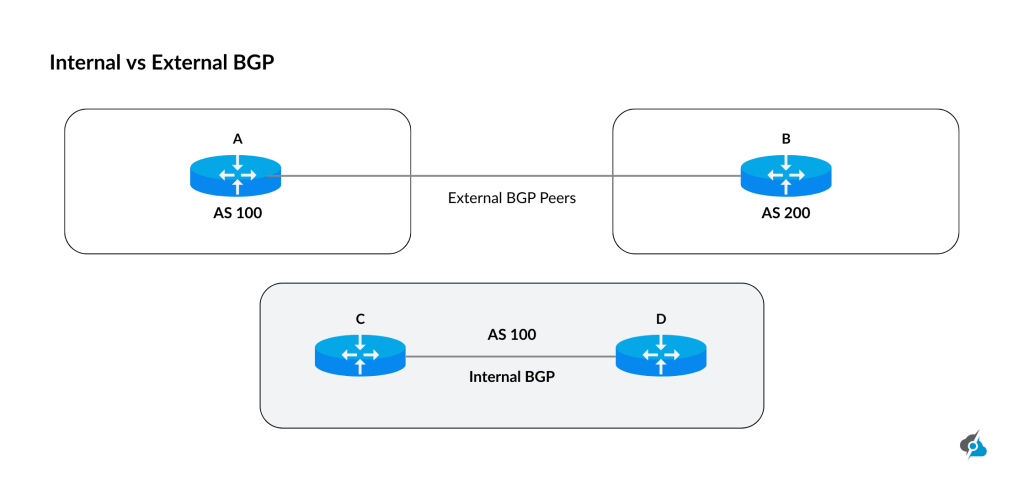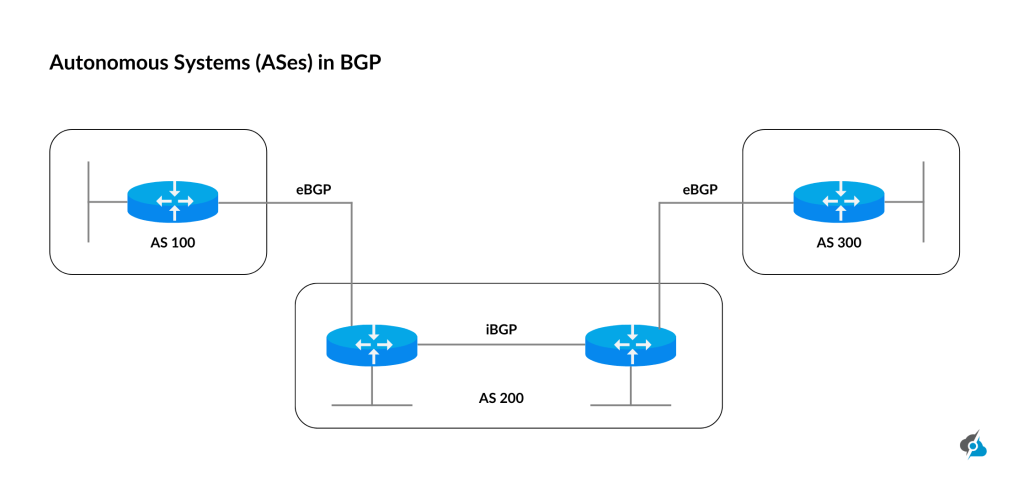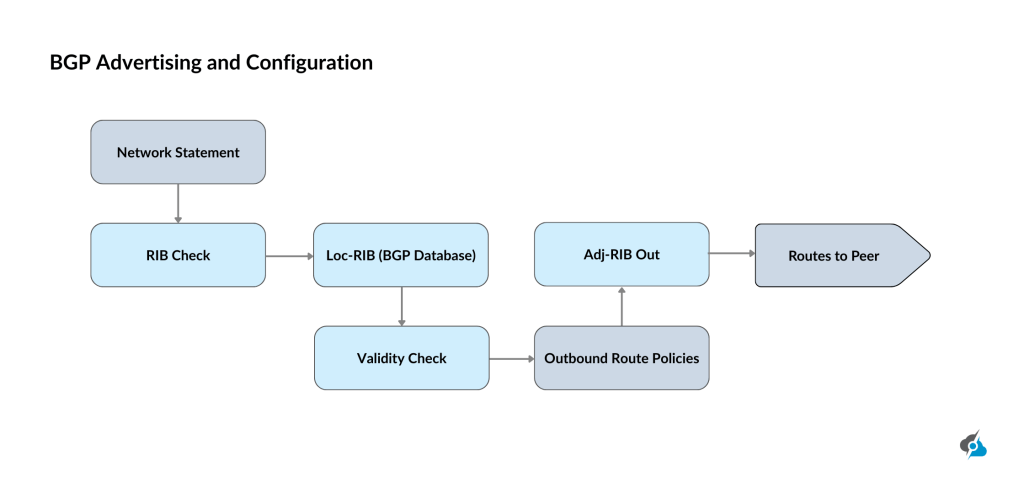BGP Routing Explained: The Complete Guide

Wondering what is BGP routing?
The Border Gateway Protocol (BGP) is in the core of the Internet’s network infrastructure, mastering data routing to link autonomous systems with precision. The BGP fundamentals reveal its role in global connectivity, from cloud platforms to enterprise networks.
ServerMania, a leading dedicated servers provider since 2008, harnesses BGP fundamentals through its IP Transit services and AraCloud cloud hosting, optimizing data routing for autonomous systems. With deep expertise in scalable network infrastructure, ServerMania empowers businesses to tackle BGP’s complexities, delivering reliable connectivity.
In this complete guide, we’ll get BGP explained and show how it charts the fastest paths, ensuring seamless data flow in 2025.
What is Border Gateway Protocol BGP
The Border Gateway Protocol (BGP) serves as the Internet’s master navigator, handling internet routing to keep global connectivity running within the vast network infrastructure.
In a nutshell, picture BGP as a traffic controller, analyzing countless paths to send data, like a video stream travelling across the globe with speed and precision.
By choosing only best routes, often hopping between independent networks, BGP ensures seamless communication for everything from websites to cloud services. This protocol underpins the Internet’s ability to deliver data efficiently, making it the foundation of modern networking systems in 2025, where reliability and speed are non-negotiable.
What is a BGP Route?
As concisely as possible, guided by classless inter domain routing, is the pathway that enables data packets to travel across the Internet’s network infrastructure, connecting hosts within and between autonomous systems through efficient data routing. Known formally as Network Layer Reachability Information or (NLRI), a route ensures a provider knows how to send and receive packets to and from a specific IP address space, making seamless, two-way communication possible.
Brief BGP History and Evolution
Crafted in the late 1980s before the commercial Internet’s rise, the Border Gateway Protocol (BGP) became a linchpin of network infrastructure, guiding data routing across autonomous systems with policy-driven precision. Standardized in 1989, BGP’s original design endures in 2025, its strengths in enforcing routing policies balanced by weaknesses like limited authentication of route claims.
Over decades, BGP evolved through added attributes, allowing tweaks at the network’s edges to meet modern demands while keeping its core framework intact. This resilience ensures BGP remains vital for seamless, global connectivity in today’s intricate systems, adapting to the ever-growing Internet traffic.
How BGP Works (BGP Routing)
The Border Gateway Protocol (BGP) handles data routing across the Internet’s network infrastructure by enabling peering, where BGP speaking routers at the edges of autonomous systems act as BGP peers or speakers to exchange routing information.
These peers perform three core functions to ensure efficient data flow:
- Route Discovery: These BGP peers swap routing information (NLRI) and path attributes, like latency or hop count, to map connectivity between autonomous systems and form a network connection graph.
- Route Storage: Each BGP router collects route advertisements, storing them in routing tables updated every 30 seconds via keep-alive messages from other routers for data routing.
- Path Selection: Using stored routing tables, BGP routers choose the shortest, most efficient path from multiple routes by evaluating attributes like cost or hops for optimal data routing.
This seamless coordination of peering and path selection makes BGP the core of Internet connectivity in 2025, ensuring data navigates the complex network infrastructure with ultimate speed and reliability.
Routing Tables: The Heart of Route Management
The BGP table, often called the routing table, is the foundation of the Border Gateway Protocol, a critical routing protocol that shapes the Internet’s network topology.
Managed by each BGP router, this global routing table stores routing information like Network Layer Reachability Information (NLRI) and path attributes, guiding the selection of multiple paths to ensure seamless connectivity in 2025.
So, by collecting advertisements, the BGP table forms a dynamic map of the network topology, updated every 30 seconds via keep-alive messages to maintain accuracy. This routing table empowers BGP routers to choose the best path from multiple paths based on attributes like AS path length or latency, preventing issues like route flapping.
The following practices optimize global routing table management:
- Limit Table Size: Filter irrelevant routes to keep the BGP table lean, easing BGP router processing.
- Validate Routes: Use RPKI to verify routing information in the routing table, enhancing security.
- Tune Updates: Configure frequent keep-alive messages to refresh the global routing table.
These strategies strengthen the BGP table, enabling BGP routers to follow multiple paths with precision, ensuring robust data routing protocol across the network infrastructure in 2025.
BGP Types: External Vs. Internal BGP
The Border Gateway Protocol (BGP) leverages internal and external BGP (External (eBGP) and Internal (iBGP)), each playing a distinct role in steering data routing across and within autonomous systems to power the Internet’s network infrastructure. These types differ in how they propagate routes, serving unique purposes for global connectivity and internal network efficiency.
Let’s unwrap internal and external routing BGP process:
External BGP
Often called External BGP or(eBGP), it connects an autonomous system to the global Internet, acting as the gateway for data to flow between independent networks. Many organizations rely on external BGP to connect their corporate networks to the broader network infrastructure, ensuring quick access to external networks.
Unlike the internal routing, external BGP routers share newly learned routes with all peers, both internal and external, to maintain robust data routing. This re-advertisement ensures that data, like a cloud service request, reaches its destination across systems efficiently.
Internal BGP
In contrast, Internal BGP (iBGP) manages the entire data routing within a single autonomous system, coordinating between smaller sub-systems inside large networks like those of ISPs or enterprises. Unlike eBGP, iBGP is optional, allowing organizations to choose alternative internal protocols based on their network infrastructure needs.
Routes learned from an BGP peer are only re-advertised to external peers, not other internal peers, often using route reflectors to prevent routing loops. This selective sharing keeps internal traffic, such as intra-company data transfers, streamlined and efficient in modern network designs.

Understanding Autonomous Systems in BGP
At the heart of the Border Gateway Protocol (BGP) lies the concept of autonomous systems (ASes), the building blocks of the Internet’s network infrastructure that enable data routing across global networks. Whether it’s a corporate network, an ISP, or a tech enthusiast’s private setup, ASes and their unique identifiers, Autonomous System Numbers (ASNs), orchestrate how data flows, making them essential to understanding BGP’s role in 2025’s interconnected landscape.

Autonomous Systems (ASes)
An autonomous system (AS) is a distinct network, an enterprise, service provider, or individual setup of network devices operating under a single administrative entity in the Internet’s network infrastructure. Each AS uses an internal routing scheme, often via protocols like OSPF or IS-IS, to ensure each internal router inside knows how to reach others within the same system.
Managed by a Network Operations Center (NOC), an AS relies on border routers to connect with other ASes, facilitating data routing through BGP TCP sessionover TCP port 179. These sessions, kept alive by 60-second keep-alive messages, allow border routers to advertise routes, enabling seamless communication and improved network performance.
Autonomous System Numbers (ASNs)
An Autonomous System Number (ASN) is a unique identifier assigned to each autonomous system, with tens of thousands in use to map the Internet’s network infrastructure. ASNs enable BGP to track data routing by distinguishing one network from another, ensuring accurate route advertisements.
Assigned by regional Internet registries, ASNs are critical for border routers to advertise routes to BGP peer or transit networks, supporting efficient IP routing.
In 2025, ASNs remain vital for scaling global connectivity, as every reachable IP address depends on an ASN-linked route to function within the broader systems framework.
Role of ASes in BGP Routing
Through BGP, autonomous systems advertise routes to their IP address spaces, enabling data routing to hosts within or beyond their networks, from local servers to global cloud services. So, border routers share these routes with peer networks or transit providers, ensuring other large networks can “hear” paths to their destinations, a cornerstone of Internet accessibility.
These route advertisements also serve critical functions beyond connectivity, such as enforcing traffic policies, tracking data paths, and preventing potential loops in the network infrastructure. So, by making semi-intelligent outbound routing decisions, ASes optimize paths, avoiding potential suboptimal routes.
BGP Protocols and Technologies
The Border Gateway Protocol (BGP) holds the Internet’s network infrastructure together, relying on a blend of protocols and tech to drive seamless data routing between autonomous systems. From core standards to cutting-edge extensions, BGP supports a suilt of tools boost the BGP ability to scale and enforce policies, keeping global network connectivity running smoothly and reliably.
BGP Support
BGP’s robust data packet routing capabilities rely on a set of complementary technologies that streamline operations within and between autonomous systems.
The following elements are critical to its performance:
- BGPv4: Launched in 1994, it supports BGP and powers data routing for internet protocol 4 and 6, using path attributes to guide smart, policy-driven decisions across network infrastructure.
- Multiprotocol BGP (MP-BGP): An advanced addition to BGPv4, that supports MPLS, VPNs (Virtual Private Networks), and multicast, expanding BGP’s reach within diverse network infrastructure setups.
- Route Reflectors: A practical fix for iBGP complexity, complementing BGP confederations by allowing one router to share routes internally, easing data routing in autonomous systems.
- BGP Communities: These handy tags mark particular routes for custom policies, helping routers route traffic flow efficiently across network infrastructure.
- BGP FlowSpec: A security tool that filters out DDoS threats to prevent network congestion, keeping data routing safe and steady for autonomous systems.
- Interior Gateway Protocols (IGPs): Protocols like OSPF and IS-IS handle internal data routing within an autonomous system, working alongside BGP.
- Route Refresh: This feature fetches fresh route updates without breaking connections, ensuring stable data routing in dynamic networks.
These technologies collectively strengthen BGP, ensuring it delivers seamless data routing and robust policy enforcement over the Internet’s network infrastructure, keeping autonomous systems connected.
Note: Curious about how IPv4 and IPv6 impact BGP routing? Check out our article on IPv4 vs. IPv6 to explore their differences and implications.
How Advertising Route BGP Works?
The Border Gateway Protocol (BGP) allows autonomous systems broadcast routes, essentially pledging clear paths for data to zip through specific IP address ranges. These route announcements are the glue binding global networks, enabling everyone from small startups to big internet service providers (ISPs).

Route Advertisements Explained
BGP advertisements signal an autonomous system’s commitment to deliver data to a defined IP range, like 192.204.4.0/24, ensuring a reliable path through the network infrastructure. Border routers leverage BGP to broadcast these routes to peers and transit providers, enabling precise data routing to connect hosts within their network seamlessly.
This process is critical for Internet accessibility, as every reachable IP address strictly depends on an advertised route, often covering a specific block of addresses managed by an autonomous system.
Here are the key aspects of advertisements:
- Route Promises: Advertising a route (e.g., 192.204.4.0/26) assures other networks that the AS can handle traffic for those IPs.
- Path Sharing: Border routers use BGP to share routes with peers or providers, building a global routing map.
- Policy Control: Advertisements include attributes to enforce routing preferences, optimizing data routing efficiency.
Single-Homed vs. Multi-Homed Networks
Single-homed networks connect to the Internet through one upstream provider, that often relies on a default route rather than BGP to simplify data routing within the network infrastructure. Since all traffic funnels through a single path, advertising specific routes is unnecessary, as the provider handles larger IP aggregates that include the network’s address space.
Multi-homed networks, however, link to multiple providers, using BGP to advertise routes and manage data routing across diverse paths, enhancing reliability and performance for autonomous systems.
BGP’s role varies by configuration:
- Single-Homed Simplicity: Static routes or default routes suffice, avoiding the need for 500,000+ BGP routes, as the provider advertises broader aggregates for data routing.
- Multi-Homed Flexibility: BGP enables load balancing and route optimization across multiple providers for robust connectivity.
- Single-Homed BGP Use Case: Multiple connections to one internet service provider may use BGP for load balancing, often with provider assistance to optimize data routing.
Hence, by mastering the advertisements, BGP ensures autonomous systems navigate the network infrastructure with precision, adapting to single or multi-homed setups.
BGP Best Practices:
By carefully prioritizing path attributes and implementing strategic policies, network administrators can enhance performance, reduce latency, and maintain stability in 2025’s intricate global networks. Below are key best practices, each with a practical example:
Favor Shortest AS Path: Select the best route with the fewest autonomous systems to ensure faster network performance by minimizing latency.
- Example: Choose a path with three AS hops (AS1 → AS2 → AS3) over a five-hop path to reduce delay for a cloud service hosted in AS3.
Leverage Local Preference: Assign higher local preference values to preferred routes within an autonomous system to align with network traffic policies.
- Example: Set local preference to 200 for a premium ISP’s route to prioritize it over a backup ISP with a default preference of 100.
Utilize MED for Multi-Homed Control: Apply Multi-Exit Discriminator (MED) to influence inbound traffic from multiple providers, optimizing data routing.
- Example: Configure MED 50 for a primary provider’s link and 100 for a secondary link to steer incoming traffic to the primary.
Filter Unverified Routes: Block routes lacking proper origin validation to enhance security, prevent route flapping and streamline network infrastructure operations.
- Example: Use RPKI to reject a route advertising 192.204.4.0/26 from an unverified AS, preventing potential hijacking.
Balance Route Load: Distribute traffic across multiple paths using load balancing to avoid congestion, enhancing data routing efficiency for autonomous systems.
- Example: Configure BGP to split traffic for 192.204.5.0/26 evenly between two ISPs, preventing overload on a single link.
These practices empower network administrators to fine-tune BGP route selection, ensuring autonomous systems navigate the network infrastructure with precision and resilience in 2025.
BGP Speakers and BGP Configuration Basics
BGP speakers, the routers tasked with exchanging routing information between autonomous systems, are the workhorses of data routing in the network infrastructure. Proper configuration of these speakers is essential to maintain stable peering sessions and enforce routing policies effectively.
BGP For Beginners: Configuring Speaker
Setting up a speaker demands precision to ensure robust data routing while aligning with the needs of the network infrastructure. Hence, proper manual configuration establishes stable connections, secures BGP sessions, and prevents errors like policy missteps or dropped links between autonomous systems.
Key steps for configuring a speaker include:
- Set Up Peering Links: Create transmission control protocol connections on port 179, sending keep-alive signals every 60 seconds to ensure stable ties between autonomous systems for smooth data routing.
- Announce IP Ranges: Declare specific address blocks, like 192.204.4.0/26, to guide outgoing traffic accurately through the network infrastructure to your network’s destinations.
- Enforce Route Controls: Use prefix lists or route maps to filter routes in and out, sharpening security and performance across autonomous systems.
- Protect Sessions: Apply MD5 or TCP-AO authentication or secure sockets layer authentication to lock down BGP connections, shielding the network infrastructure from unwanted access.
- Track and Log Activity: Deploy monitoring tools to watch BGP session health and catch any data routing flapping, keeping operations steady.
Following these steps equips BGP speakers to handle data routing with accuracy and security, enabling autonomous systems to maintain seamless connectivity across the network infrastructure in 2025.

Conclusion: Finding the Best Route with ServerMania!
In 2025, mastering BGP ensures the best route for seamless data routing across the Internet’s network infrastructure, connecting autonomous systems with precision and reliability.
ServerMania, a trusted leader in dedicated servers, leverages its BPT routing protocol expertise through IP Transit services and cloud hosting to empower businesses with optimized network performance.
Talk to an expert today to elevate your network strategy with ServerMania’s tailored solutions!
Was this page helpful?

